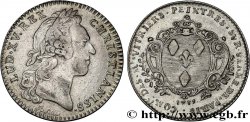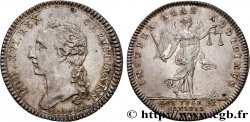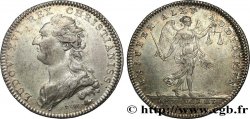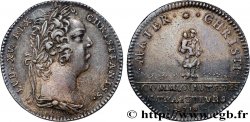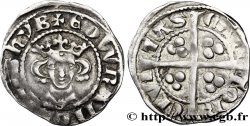fjt_233753 - CORPORATIONS LES BOUCHERS - Jeton doré et émaillé n.d.
Not available.
Item sold on our e-shop (2012)
Price : 550.00 €
Item sold on our e-shop (2012)
Price : 550.00 €
Type : LES BOUCHERS - Jeton doré et émaillé
Date: n.d.
Metal : gilt copper
Diameter : 28 mm
Orientation dies : 6 h.
Weight : 6,46 g.
Edge : brute
Rarity : R3
Coments on the condition:
Ce jeton est frappé sur un flan large et régulier. Il présente un trou au niveau du Q de la légende du droit
Catalogue references :
Obverse
Obverse legend : RIEN NEST MEILLEVR QVE VIVRE EN VNITE.
Obverse description : Quatre écus posés en croix aux armes de Saint-Yon, Ladehors, Thibert et d’Auvergne.
Reverse
Reverse legend : IL FAICT BON VEOIR CONCORDE FRATERNEL.
Reverse description : Armes de la boucherie, dans une couronne de feuillage.
Commentary
Cet exemplaire est tout à fait exceptionnel car il a été non seulement doré mais laqué en rouge dans le champ du revers, lequel porte dans son axe un petit trou de suspension.
Jeton de passage ou de reconnaissance, cet exemplaire a certainement été porté et utilisé par un maître important de la corporation. Nous n’avons jamais vu de jeton de corporation apprêté de la sorte. Ce jeton non daté est une variante non signalée dans Feuardent ou Corre. De par son style, il est probablement du XVIe siècle.
Jeton de passage ou de reconnaissance, cet exemplaire a certainement été porté et utilisé par un maître important de la corporation. Nous n’avons jamais vu de jeton de corporation apprêté de la sorte. Ce jeton non daté est une variante non signalée dans Feuardent ou Corre. De par son style, il est probablement du XVIe siècle.








 Report a mistake
Report a mistake Print the page
Print the page Share my selection
Share my selection Ask a question
Ask a question Consign / sell
Consign / sell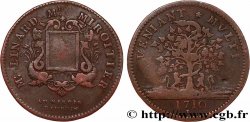
 Full data
Full data